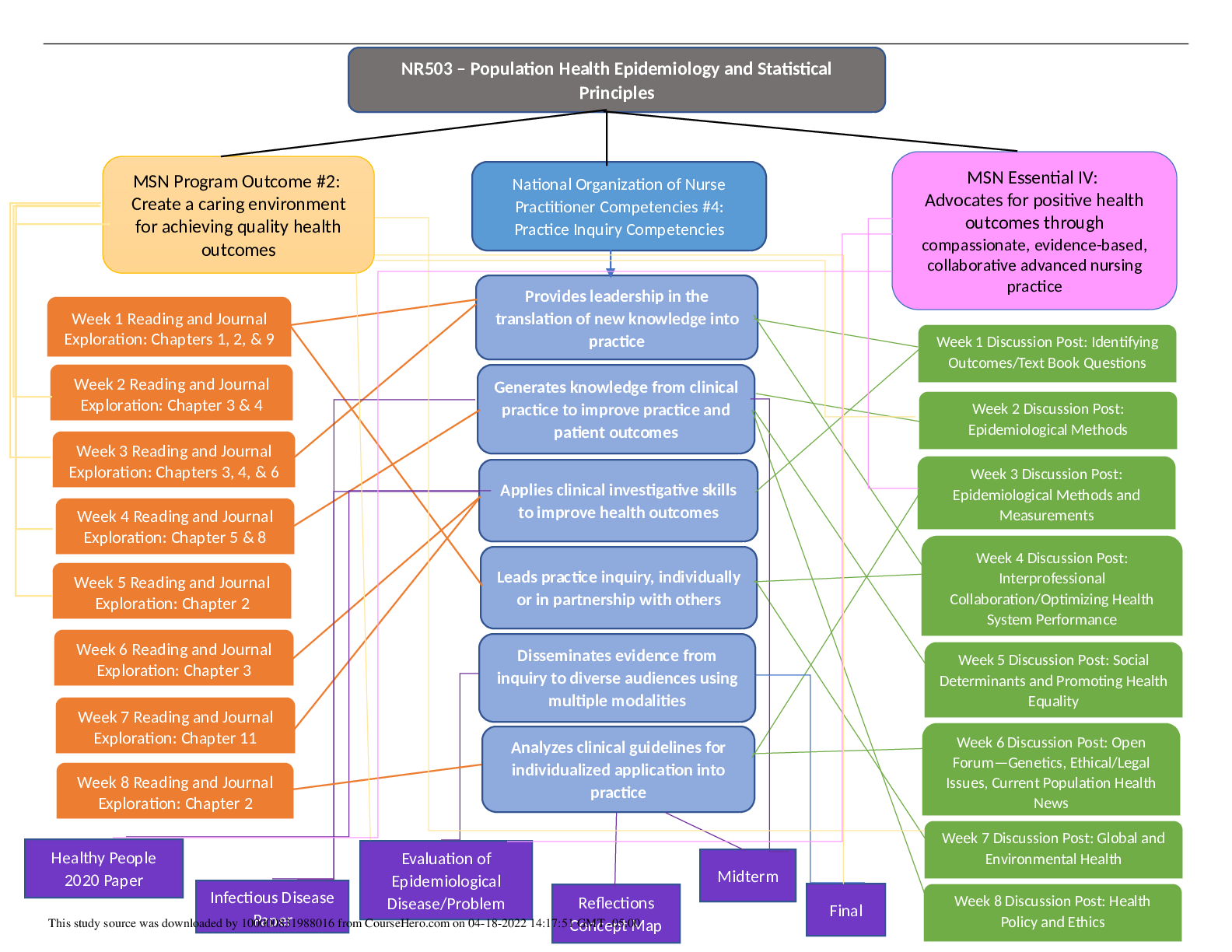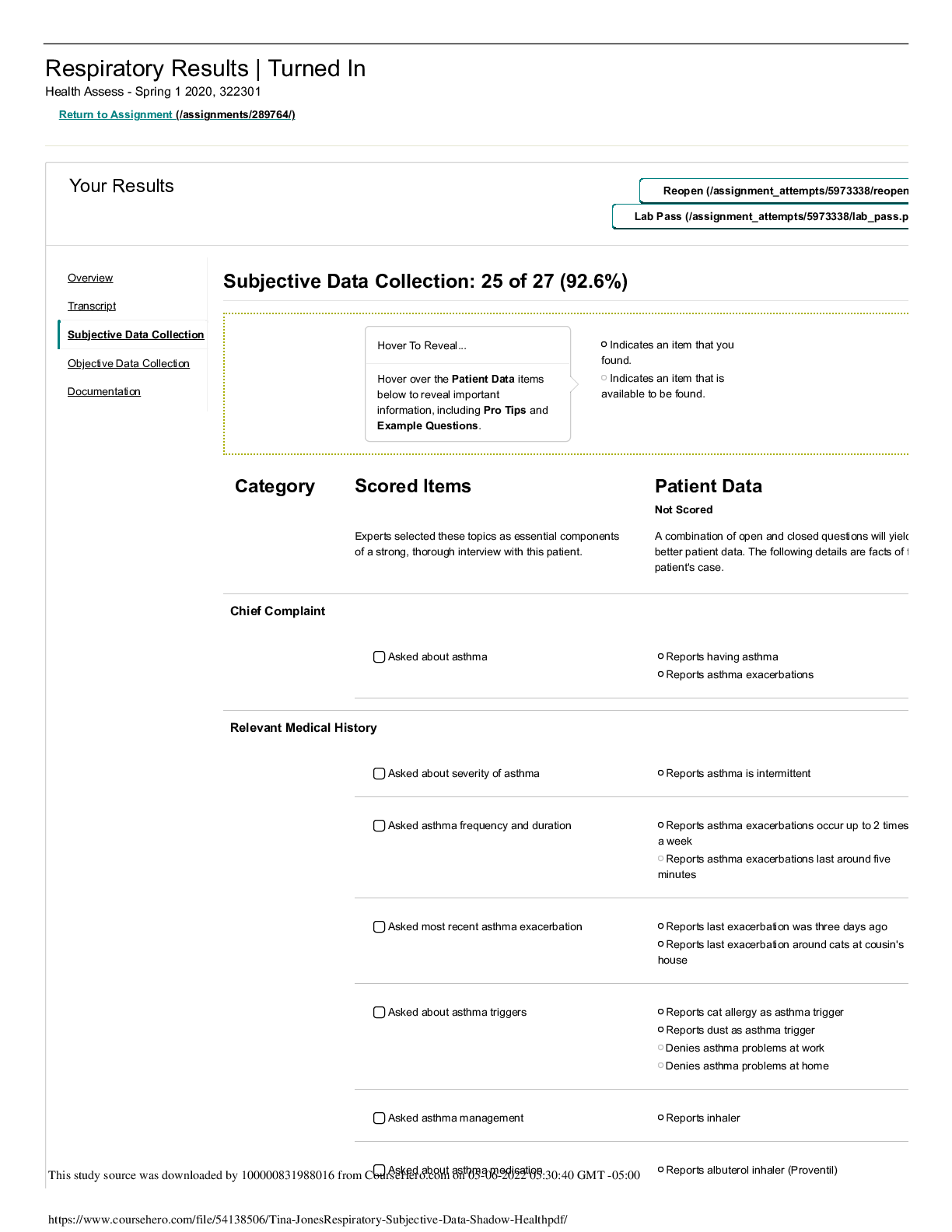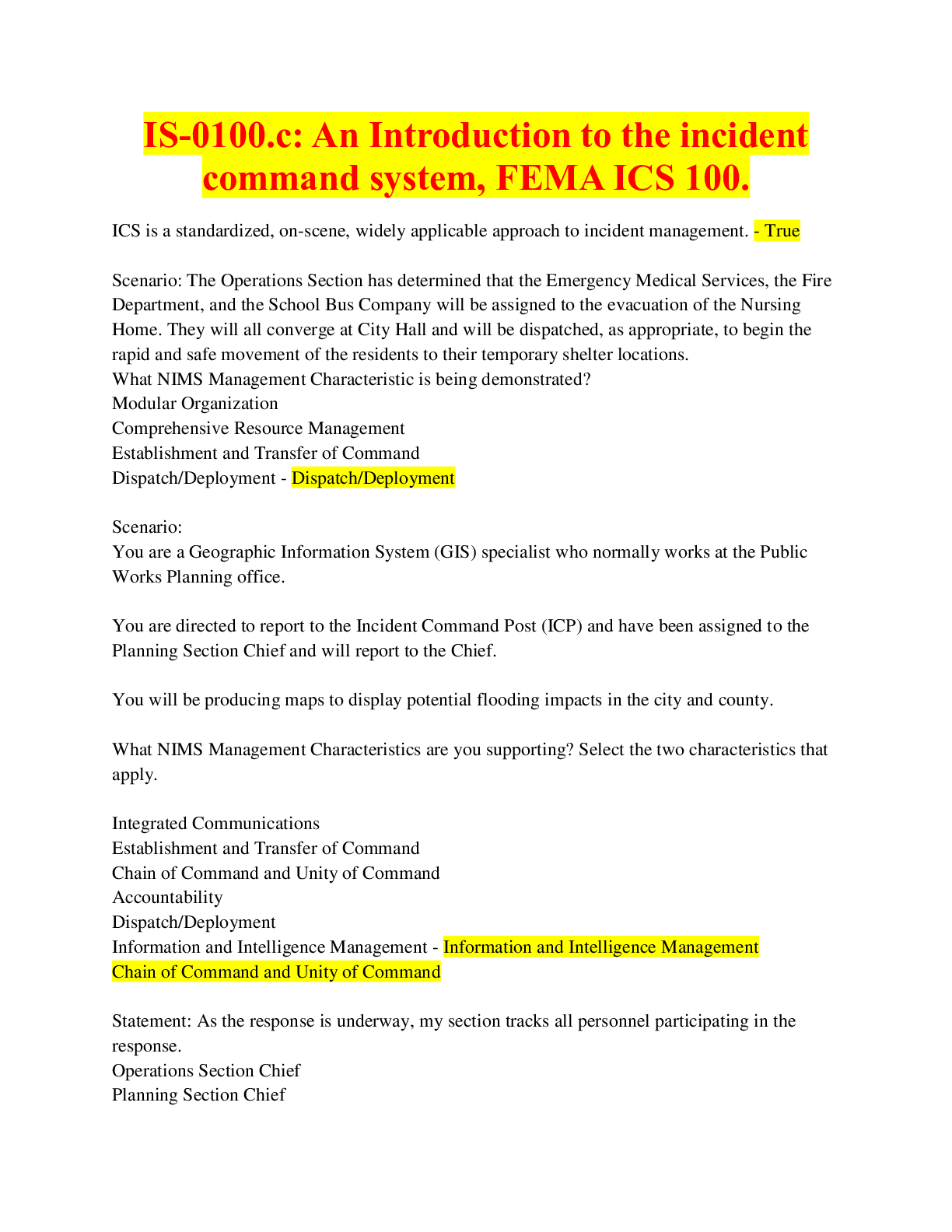*NURSING > EXAM > Certified Pediatric Nurse Practitioner (CPNP) Testbank Exam Questions & Answers (All)
Certified Pediatric Nurse Practitioner (CPNP) Testbank Exam Questions & Answers
Document Content and Description Below
Certified Pediatric Nurse Practitioner (CPNP) Testbank Exam Questions & Answers-The concept of health promotion consists of efforts to prevent rather than to cure disease or disability. This descripti... on best describes: a. tertiary prevention b. secondary prevention c. primary prevention d. morbidity prevention - c Standards for well child care and health promotion are set forth by the: a. Task Force on Preventative Services, US Department of Health and Human services b. American Academy of Family Physicians c. American Academy of pediatrics d. Healthy People 2010 and 2020 - c A 15 yo female comes to the clinic for a health maintenance visit. The patient reports no complaints. She does well in school, has many friends, and gets along well with her parents and two siblings. She has recently become sexually active with her boyfriend of 6mo. The physical exam is normal for her age. What screening, lab tests, and/or immunizations should the PNP order? a. Vision, hearing, urinalysis, STD screen, pelvic exam, and immunizations as needed b. STD screen, pneumococcal vaccine, pelvic exam, and cholesterol screening as indicated c. vision, hearing, STD screen, pelvic exam, and hemoglobin if indicated. d. Measles vaccine, vision, hearing, STD screen, pelvic exam exam, and cholesterol screen if indicated. - a Which of the following is the best written chief complaint? a. 5yo asian female with itchy red rash b. 1 mo with difficulty feeding c. 15yo african american female complaining of lower abdominal pain for 3 days d. 12yo caucasian with itchy eye for 1 week - c The past history should include a. family history b. social hx c. symptom analysis d. hospitalization - d The family history should include: a. the health status of the paternal grandparents b. the living conditions of the family c. the work status of the parents d. school information - a Which of the following statements would be considered subjective data obtained from the client during the review of systems for the skin? a. the skin appears dry & excoriated b. a lesion is noted on the lateral aspect of the right leg c. there is moderate acne on the forehead and back d. the patient denies changes in skin texture - d The PNP is completing the ROS on a 4mo. What response from the mother might indicate a cardiac problem in the infant & require a more thorough history? a. the baby gets the hiccups often. b. it takes the baby over 30min to complete a bottle c. the baby's heart seems to beat rapidly sometimes d. sometimes the baby sounds congested - b The PNP is obtaining a review of systems on a healthy 8yo girl. It would be important to include: a. the date of last breast self-exam. b. any limitations related to sports participation. c. the last hematocrit and hemoglobin d. the last lead screen - b The mother of a 3yo states that her son was completely toilet trained at 18mo. The PNP explores further, asking: a. how the mother did the toilet training b. if the child is dry at night and fully trained for urine and stool day and night c. at what age did the mother begin toilet training the other child. d. if the child gets up at night to use the bathroom - b Jasmine, a 5-month-old infant is in the clinic for a well child visit and is sleeping in her mother's arms. What should the PNP do first? a. Examine the ears, since this is uncomfortable for the infant. b. Quickly give any needed immunizations. c. Begin with assessment of the head and proceed from head to toe. d. auscultate the heart & lungs while the infant is sleeping. - d The mother of a newborn brings the baby to the clinic because she is afraid something is wrong with her baby ("his head is so big"). The PNP responds that: a. "this is normal. The head of a newborn is proportionately large to the rest of the body" b. "Yes, this does appear abnormal. I will make an appointment for the baby to be seen by a neurologist." d. "your head appears large so it is probably genetic." - a A healthy 12yo female is at the clinic for a well checkup. On physical examination, a marked elevation of the right scapula and right thoracic hump and spinal curve abnormally are noted. Spinal films indicate 20 degree curve. The PNP should: a. refer the patient to an orthopedist b. monitor the patient every 3 mo until menarche c. refer the patient for physical therapy d. recommend bedrest and back brace - a What is the % of risk an autosomal dominant gene is being passed on to each offspring? a. 25 b. 50 c. 100 d. none - b A 13yo female is at the clinic for a routine check up. What presenting symptoms might alert the PNP to the presence of a possible genetic disorder? a. <10% on growth chart, Tanner I, and learning difficulties b. Precocious puberty, developmental delays, gifted piano player c. Lactose intolerance, frequent ear infections, speech delays d. Peanut allergy, right-sided weakness, and exhibits bullying behavior - a The parents of a child with cystic fibrosis are considering another pregnancy. They want to know what their chances are of having another child with cystic fibrosis. The PNP explains that cystic fibrosis is an autosomal recessive disorder and that each conception of carrier parents has a: a. 25% chance of being affected b. 50% chance of being affected c. 75% chance of being affected d. 100% chance of being affected - a The parents of a son with hemophilia are considering another pregnancy. The mother has been identified as a carrier of the hemophilia gene. What chance does each female offspring have of having hemophilia. a. 100% b. 50% c. 25% d. none - d A male with Vitamin D-resistant rickets asks what his chances are of passing his disease to his parents. The PNP answers: a. all sons will be affected by only 25% daughters b. all daughters are affected by only 25% sons c. 50% of all offspring will have the disease d. all daughters will be affected but no sons. - d The PNP is following a 15-year-old male adolescent with consistent blood pressure readings of 132 to 138/84 to 86 mm Hg, which is classified as significant hypertension. After performing a workup, the PNP determines that the adolescent has primary hypertension. The most judicious recommendation for therapy is: A) Diet and exercise counseling and referral to a specialist B) A diuretic, low-salt diet, exercise, and counseling by a dietician C) Perform an extensive family history to determine other risk factors D) A vasodilator, restricted activity, and a low-fat diet - a The PNP is examining a neonate with a heart murmur. The S2 sound is loudest at the apex. The respiratory rate is 65 breaths per minute, and the heart rate is 180 beats per minute. Which of the following would be an appropriate action by the PNP? A) Reevaluate the neonate in 24 hours B) Increase the number of oral feedings C) Order cardiac catheterization D) Refer the neonate to a cardiologist - d A 2-week-old neonate is brought to the clinic with excessive lacrimation of both eyes. The eyes are clear, with no areas of redness, but the corneas appear hazy. The PNP explains to the parents the possible diagnosis and treatment as follows: A) Congenital glaucoma requiring an ophthalmology referral B) Corneal foreign body requiring fluorescein staining and removal C) Chalazion requiring treatment with antibiotic eyedrops D) Allergic conjunctivitis requiring treatment with Benadryl eyedrops - a On examination of a 3-month-old infant the PNP is unable to elicit a red reflex in the right eye. Previous examinations failed to note the presence or absence of a red reflex. The PNP's response is to: A) Reassure the parents that this is not a problem because the infant has dark eyes B) Note this finding in the infant's chart and check again in a few months C) Refer the infant to an ophthalmologist to rule out retinal trauma D) Immediately refer the infant to a pediatric ophthalmologist to rule out a congenital cataract or retinoblastoma - d A 4-year-old child with chickenpox has vesicles on the skin of the right eyelid. The child complains of eye pain and blurred vision. The PNP should treat the condition by: A) Applying cool compresses to the eye and lesions B) Prescribing eyedrops containing steroids to decrease inflammation and pain C) Prescribing polyspoium ophthalmic ointment for the secondary bacterial infection D) Immediately referring the child to an ophthalmologist - d An adolescent is being seen at a community health center because of recurrent respiratory tract infections. The complete blood cell count (CBC) with differential shows a white blood cell count of 20,500 with 35% blast cells. The next step in managing the adolescent's care is to: A) Repeat the CBC with differential in 1 week B) Refer to a specialist in pediatric hematology C) Perform bone marrow aspiration D) Hospitalize the adolescent immediately - b A 9-month-old infant was diagnosed with sickle cell disease shortly after birth. The mother telephones the PNP to report that the infant has a fever of 103.2°F. The best response to the mother is: A) "Take the infant to the emergency room immediately." B) "Administer a dose of ibuprofen, and call back in 6 hours if the fever continues." C) "Give extra fluids and acetaminophen, and call back tomorrow if the fever continues." D) "Give extra fluids and acetaminophen, and bring the infant to the clinic tomorrow morning." - a A 5-year-old child has sudden onset of nonblanching purpuric lesions scattered over the body and petechiae scattered over the neck and shoulders. The mother reports that the child has been healthy, except for a cold a few weeks ago. The child is not taking any medications. Physical examination reveals a healthy, afebrile child with no other significant findings. The laboratory data show a hemoglobin level of 12.5 g/dL, white blood cell count of 6500/mm3, and platelet count of 20,000/mm3. Based on this information, what should the PNP do next? A) Reassure the parents that these findings are consistent with acute idiopathic thrombocytopenia purpura (ITP), and advise a hematology consultation for confirmation B) Refer the child immediately to the pediatric hematology/oncology department of the nearest tertiary care center C) Report the family to the local protective services department as soon as possible because of the - a A 4-year-old child is scheduled for a tonsillectomy and adenoidectomy. The preoperative laboratory tests indicate a prolonged active partial thromboplastin time (aPTT). The PNP should suggest that they: A) Continue with the surgery, and monitor the child closely for bleeding complications B) Cancel the surgery, and recheck the aPTT in 1 week C) Cancel the surgery, and refer the child to a hematologist D) Obtain a family history, and determine whether there are other relatives with a bleeding disorder - c A 14-year-old adolescent, who appears to be in acute distress and is anxious, is brought to the clinic with symptoms of high fever, chills, malaise, pharyngitis, vomiting, peripheral cyanosis, tachypnea, tachycardia, low blood pressure, and erythroderma. The PNP recognizes this as toxic shock syndrome and: A) Orders a CBC and blood culture immediately B) Orders a CBC and blood culture, and sends the adolescent to an emergency room for a lumbar puncture C) Sends the adolescent to the emergency room by ambulance immediately without providing any treatment in the clinic D) Collaborates with the clinic physician to determine appropriate antibiotic use in this patient - c [Show More]
Last updated: 2 weeks ago
Preview 5 out of 277 pages
Instant download

Loading document previews ...
Buy this document to get the full access instantly
Instant Download Access after purchase
Add to cartInstant download
Reviews( 0 )
Document information
Connected school, study & course
About the document
Uploaded On
Jun 07, 2024
Number of pages
277
Written in
Additional information
This document has been written for:
Uploaded
Jun 07, 2024
Downloads
0
Views
11
















